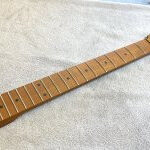David Bowie, a name synonymous with innovation and reinvention, left an indelible mark on music history. While celebrated for his chameleonic personas and groundbreaking music, one facet of Bowie’s artistry often goes unsung: David Bowie, the guitarist. Though he may not have been a guitar virtuoso in the vein of some of his collaborators, his guitar choices were as deliberate and fascinating as his ever-evolving musical styles. Bowie surrounded himself with exceptional guitarists like Mick Ronson, Carlos Alomar, Earl Slick, and Robert Fripp, yet his own relationship with the guitar is a story worth exploring. Let’s delve into the world of David Bowie Guitars, showcasing the instruments that accompanied him through his remarkable career.
Exploring David Bowie’s Guitar Collection
David Bowie’s taste in guitars was as eclectic and refined as his music. He favored vintage and rare instruments, and his selections often mirrored his current musical direction. While primarily known for electric guitars, Bowie held a special fondness for 12-string acoustic guitars throughout his career. His guitar journey is a testament to his connoisseurship and provides a fascinating glimpse into his musical evolution.
Here are 20 remarkable guitars that defined David Bowie’s career.
1) 1965-66 Framus 12-String Acoustic: The Early Days
Before the Ziggy Stardust persona and stadium anthems, David Bowie, then David Jones, was finding his footing in the music world. Initially a saxophone player and frontman, the guitar wasn’t his first instrument. However, this image of a young David Jones with a Framus 12-string acoustic guitar represents his earliest documented foray into guitar playing.
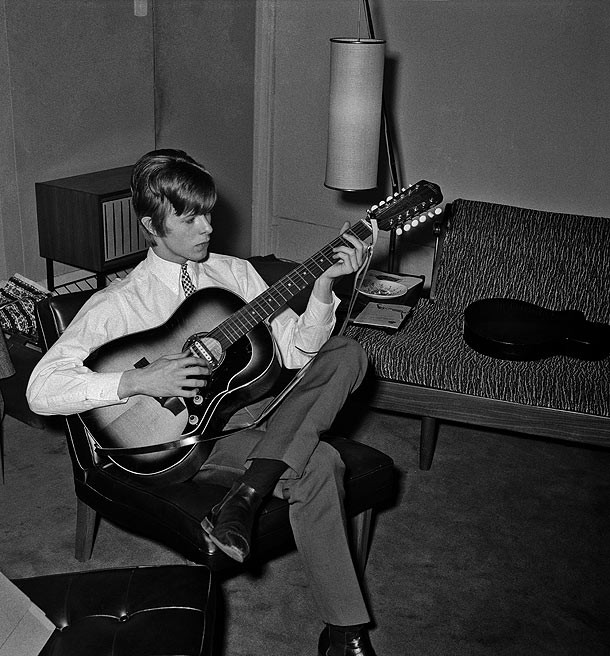 Young David Bowie with a Framus 12-string acoustic guitar circa 1965-66
Young David Bowie with a Framus 12-string acoustic guitar circa 1965-66
Alt text: David Bowie in his youth, around 1965-66, holding a redburst Framus 12-string acoustic guitar.
According to biographer Paul Trynka, Bowie acquired a guitar in late 1965. Given his later affinity for 12-string acoustics, it’s plausible that this Framus was his first guitar. Intriguingly, the guitar featured pickups and tone/volume controls, suggesting it might have been a modified or second-hand purchase for the then-struggling musician. This Framus guitar marked a crucial step in Bowie’s songwriting journey, as he began composing songs like “Maid Of Bond Street” and “Can’t Help Thinking About Me” using this very instrument.
2) 1968-69 Gibson B-45 12-String: Folk Influences
Following the commercial disappointment of his 1967 debut album, Bowie explored diverse creative avenues. This period included joining Lindsey Kemp’s mime troupe, delving into Buddhism, and forming the folk-inspired trio Feathers with Hermione Farthingale and John Hutchinson. During this phase, Bowie played a Gibson B-45 12-string acoustic guitar.
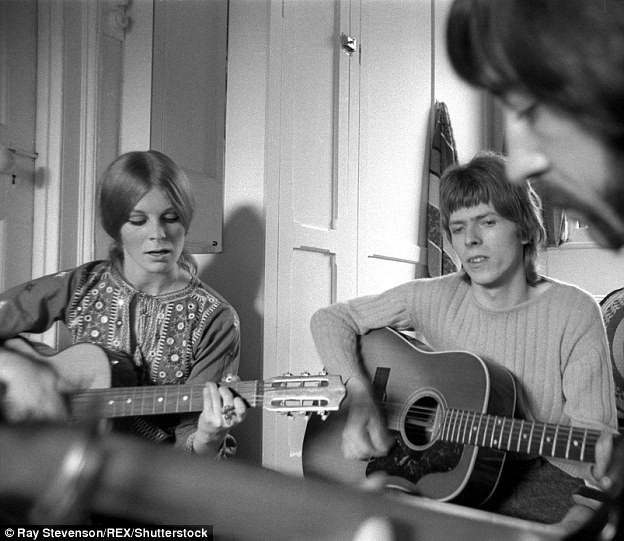 David Bowie performing live with Feathers, playing a Gibson B-45 12-string acoustic guitar
David Bowie performing live with Feathers, playing a Gibson B-45 12-string acoustic guitar
Alt text: David Bowie performing live with the band Feathers, playing a vintage Gibson B-45 12-string acoustic guitar.
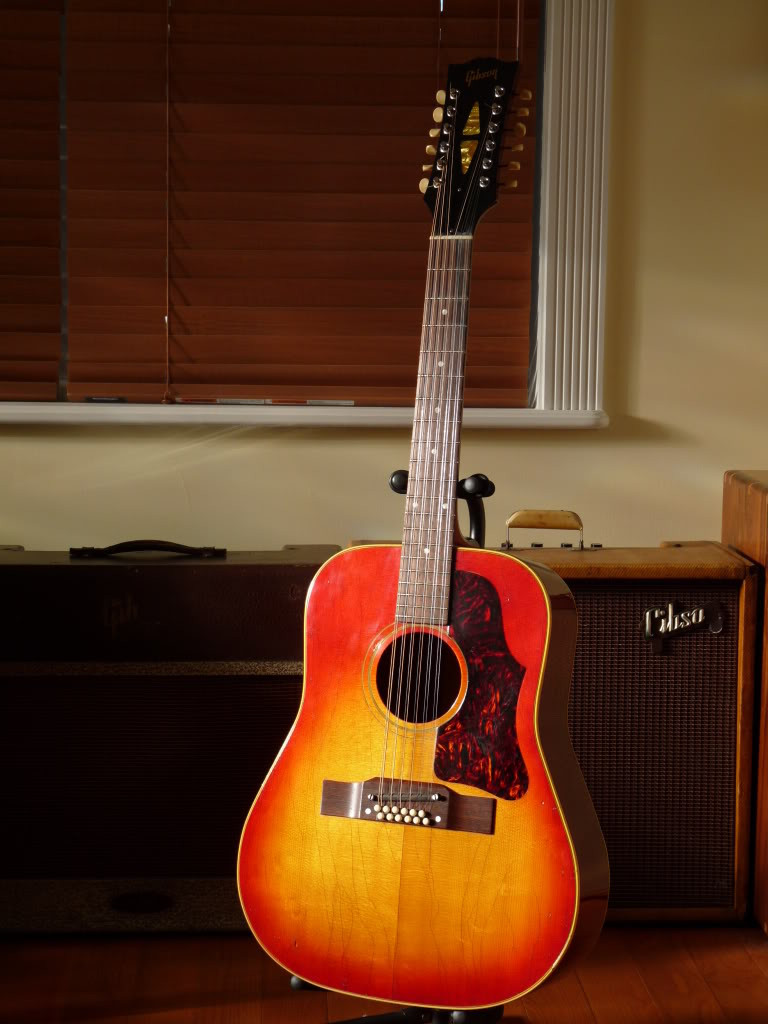 Gibson B-45 12-string acoustic guitar, similar to David Bowie's instrument from 1968-69
Gibson B-45 12-string acoustic guitar, similar to David Bowie's instrument from 1968-69
Alt text: Close-up of a Gibson B-45 12-string acoustic guitar, the model used by David Bowie during his Feathers period.
This Gibson B-45 remains a relatively obscure piece of Bowie’s guitar history, rarely mentioned in connection with him. After the Feathers era, this guitar seemingly disappeared from Bowie’s repertoire, making this a unique and lesser-known chapter in his instrumental journey.
3) 1969-1972 Hagstrom 12-String Acoustic: The Space Oddity Era
Perhaps the most iconic acoustic guitar associated with David Bowie, the Hagstrom 12-string holds a special place in his early career. It is widely believed to be the instrument he used to pen his breakthrough hit, ‘Space Oddity.’ This Hagstrom also accompanied him live and served as his primary songwriting tool during the formative ‘Ziggy Stardust’ era, contributing to classics like ‘Starman’.
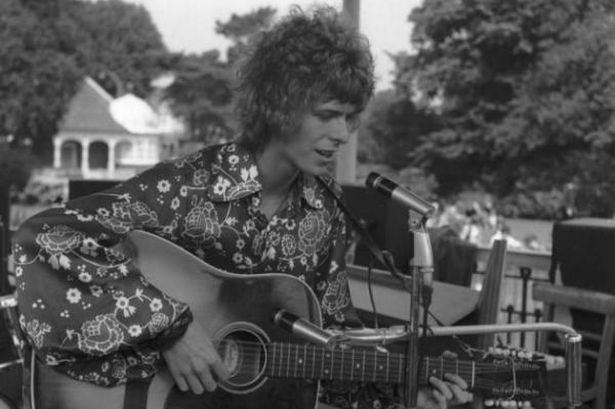 David Bowie performing live at the Beckenham Free Festival in 1969, playing his Hagstrom 12-string acoustic guitar
David Bowie performing live at the Beckenham Free Festival in 1969, playing his Hagstrom 12-string acoustic guitar
Alt text: David Bowie playing a Hagstrom 12-string acoustic guitar at the Beckenham Free Festival in 1969.
Interestingly, this legendary Hagstrom is now on display at the ‘Beatles Story’ museum in Liverpool. It appears that pickups and tone/volume controls were added to the guitar at some point, although photographic evidence of Bowie using it in this modified configuration is scarce.
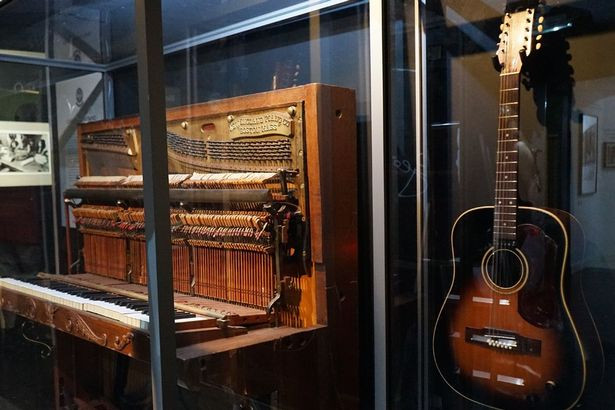 David Bowie's Hagstrom 12-string acoustic guitar on display at the Beatles Story museum in Liverpool
David Bowie's Hagstrom 12-string acoustic guitar on display at the Beatles Story museum in Liverpool
Alt text: David Bowie’s Hagstrom 12-string acoustic guitar exhibited at the Beatles Story museum, displayed near John Lennon’s piano.
4) 1969 Espana 12-String Acoustic: The Promo Prop?
This Espana 12-string acoustic guitar is primarily known for its appearance in a promotional photoshoot for the ‘Space Oddity’ single. However, information about its actual use by Bowie remains scarce.
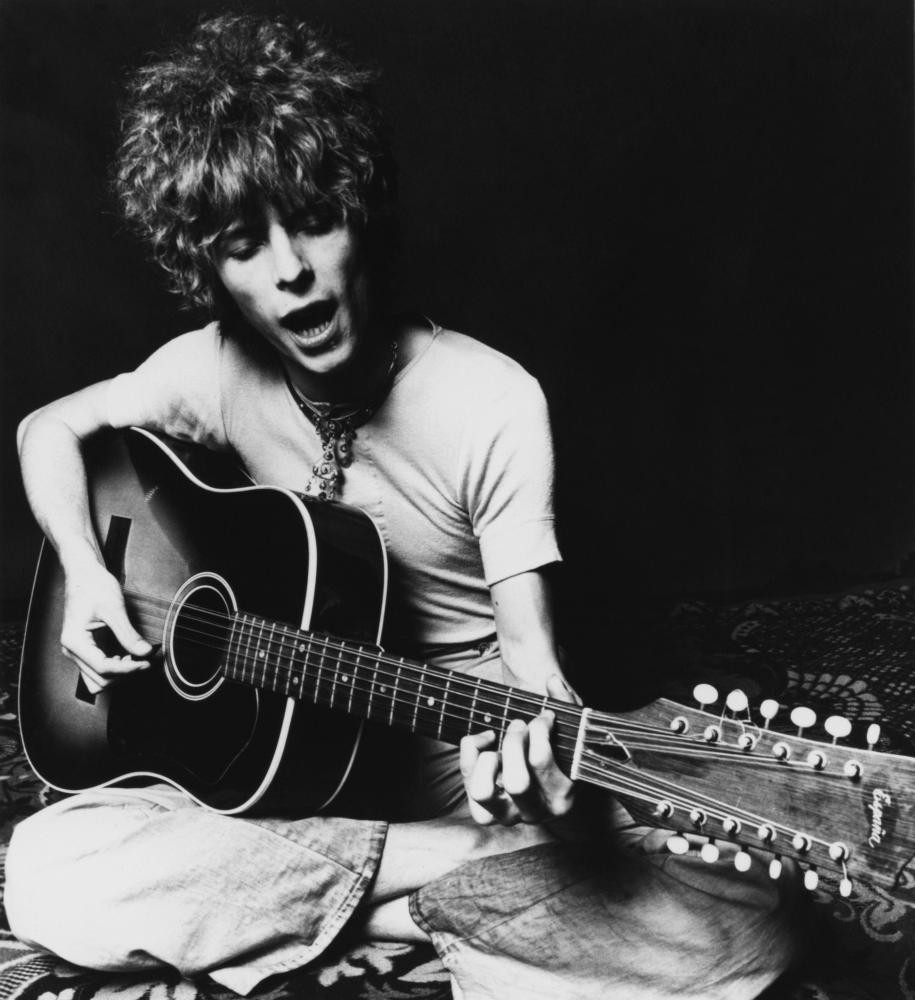 David Bowie posing with his Espana 12-string acoustic guitar in 1969
David Bowie posing with his Espana 12-string acoustic guitar in 1969
Alt text: David Bowie holding an Espana 12-string acoustic guitar during a photoshoot in 1969.
It’s speculated that the Espana might have served primarily as a prop for the photograph. Its visual similarity to the Hagstrom 12-string raises the possibility that it could even be the same guitar, appearing in different photos and footage under slightly different guises. However, definitive confirmation remains elusive.
5) 1971 Guild 12-String Acoustic: US Tour Companion
During his first US tour in 1971, promoting ‘The Man Who Sold The World,’ David Bowie was seen playing a Guild 12-string acoustic guitar. There are no records or images of him using a Guild 12-string before or after this tour, suggesting it might have been a borrowed instrument specifically for the American leg of his promotional efforts.
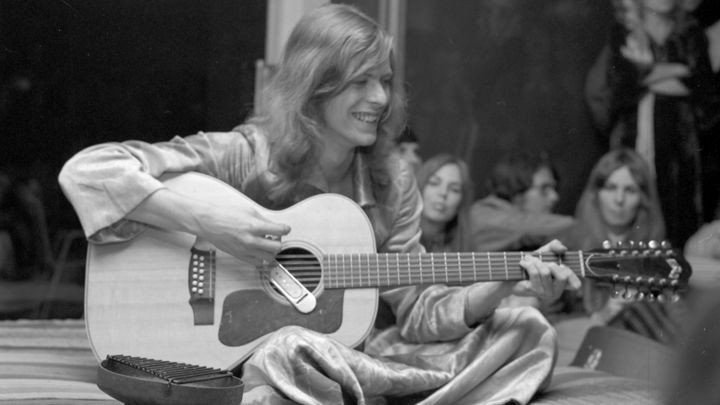 David Bowie performing live in 1971 with a Guild 12-string acoustic guitar
David Bowie performing live in 1971 with a Guild 12-string acoustic guitar
Alt text: David Bowie playing a Guild 12-string acoustic guitar live on stage in 1971 during his US tour.
6) 1972-83 Harptone 12-string Acoustic: The Ziggy Era Staple
This Harptone 12-string acoustic guitar became synonymous with Bowie’s iconic Ziggy Stardust persona. It was “the” Ziggy-era acoustic, frequently used during tours with the Spiders From Mars and prominently featured in most visual recordings from that period.
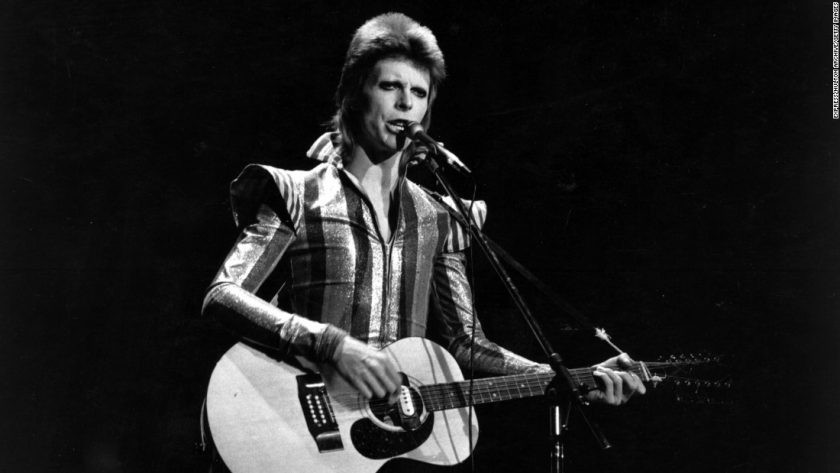 David Bowie with his Harptone 12-string acoustic guitar during the Ziggy Stardust era
David Bowie with his Harptone 12-string acoustic guitar during the Ziggy Stardust era
Alt text: David Bowie pictured with his Ziggy-era Harptone 12-string acoustic guitar.
Remarkably, Bowie revived this Harptone years later, even after the ‘Let’s Dance’ era, as evidenced by live photographs from that time, proving its enduring appeal in his guitar collection.
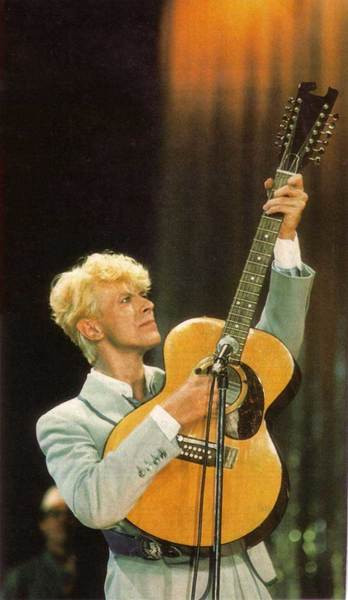 David Bowie in the eighties playing his Ziggy-era Harptone acoustic guitar
David Bowie in the eighties playing his Ziggy-era Harptone acoustic guitar
Alt text: David Bowie in the 1980s playing the same Harptone 12-string acoustic guitar he used during the Ziggy Stardust period.
7) 1972-75 Harptone 12-String Jumbo: The Ziggy Companion
Less widely recognized, Bowie also regularly played another Harptone 12-string, a Jumbo model. While visually similar to the standard Harptone 12-string at first glance, closer inspection reveals a different scratchplate and a larger body size. This Jumbo Harptone was featured in the second ‘Space Oddity’ video (from the Ziggy era), during the Ziggy tour itself, and remained in use through the ‘Young Americans’ period.
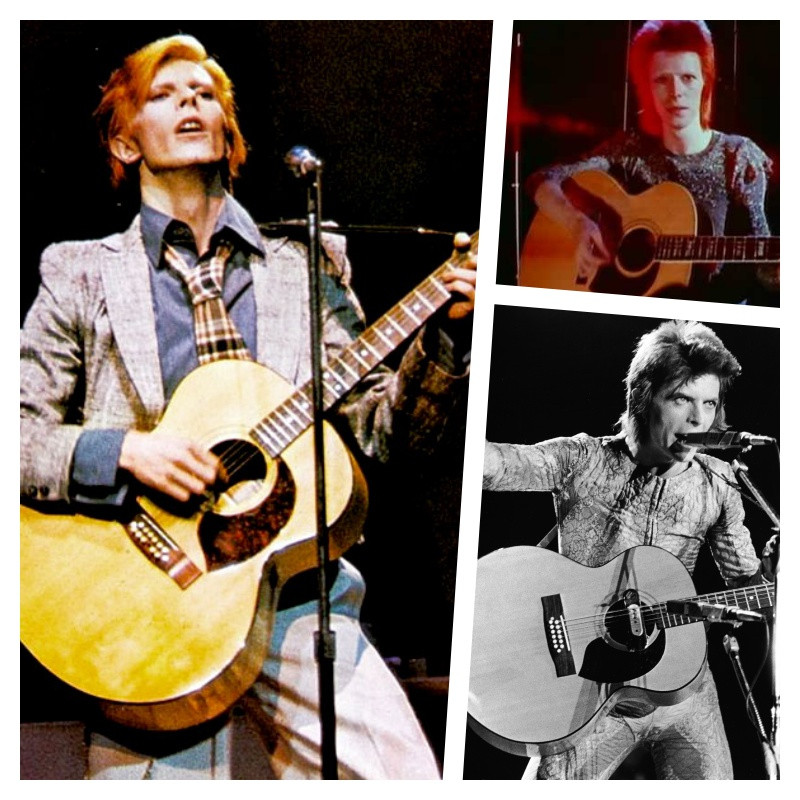 Collage showing David Bowie with his Harptone 12-string Jumbo acoustic guitar
Collage showing David Bowie with his Harptone 12-string Jumbo acoustic guitar
Alt text: Collage image showcasing David Bowie playing his Harptone 12-string Jumbo acoustic guitar across different performances.
8) 1972 Egmond 12-String, Blue: Top of the Pops Fame
This blue Egmond 12-string guitar holds a significant place in Bowie’s history, primarily for being the instrument he played during his pivotal ‘Starman’ performance on Top Of The Pops. This performance is widely credited with catapulting Bowie to mainstream pop stardom in the UK. He also used the Egmond in several promotional photos, solidifying its iconic status in his early Ziggy period.
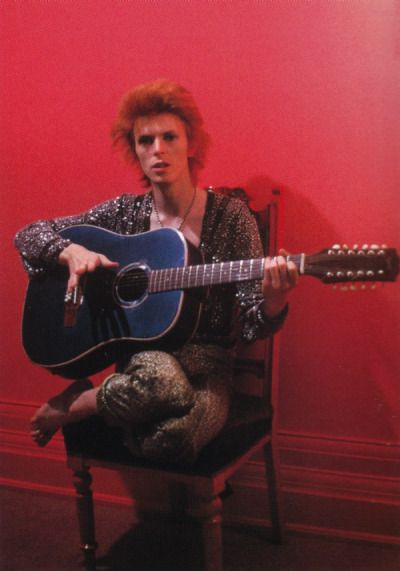 David Bowie holding his blue Egmond 12-string guitar
David Bowie holding his blue Egmond 12-string guitar
Alt text: David Bowie holding and playing his distinctive blue Egmond 12-string guitar.
9) 1972 Vox Teardrop Mark XII 12-String: Promo Appearance
While there is no record of Bowie using this distinctive Vox Teardrop Mark XII 12-string guitar beyond 1972 promotional photographs, it remains a visually striking instrument in his collection. Interestingly, years later, he utilized a Vox Teardrop Mark VI (a 6-string model) for recording ‘Absolute Beginners,’ one of his most acclaimed songs from the 1980s. The Vox Teardrop Mark XII is currently displayed at the Hard Rock Cafe in Warsaw.
 David Bowie with a Vox Teardrop Mark XII 12-string guitar
David Bowie with a Vox Teardrop Mark XII 12-string guitar
Alt text: David Bowie pictured with a unique Vox Teardrop Mark XII 12-string guitar.
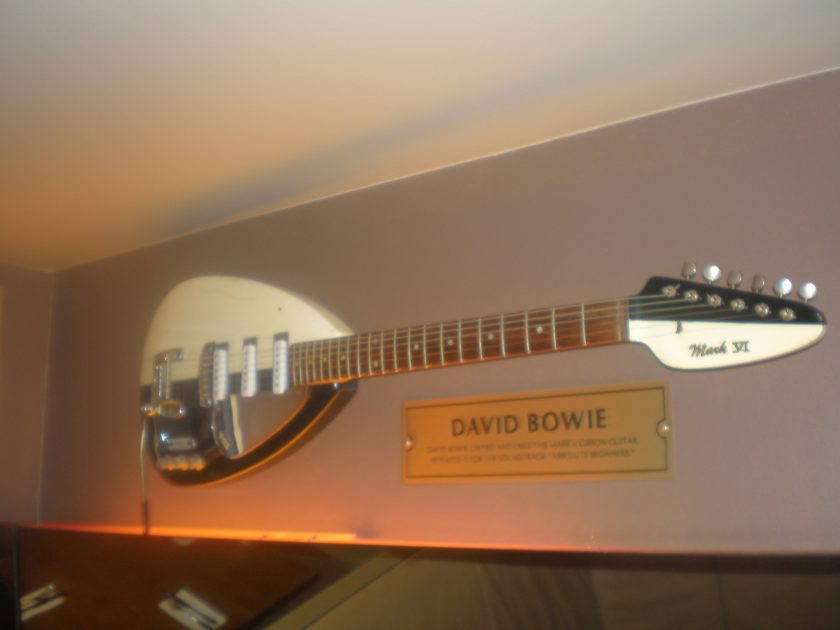 David Bowie's Vox Mark VI guitar on display at the Hard Rock Cafe in Warsaw
David Bowie's Vox Mark VI guitar on display at the Hard Rock Cafe in Warsaw
Alt text: David Bowie’s Vox Mark VI 6-string guitar showcased at the Hard Rock Cafe in Warsaw.
10) 1972 Gibson 1972 Deluxe Les Paul: Rock ‘n’ Roll Image
David Bowie was always acutely aware of his image and its symbolic power. Posing with a borrowed Gibson Les Paul on the cover of the “Ziggy Stardust And The Spiders From Mars” album cover was a deliberate move to project a tougher, more rock-oriented persona. This image strategy extended to his 1972 USA tour, where he used a Les Paul.
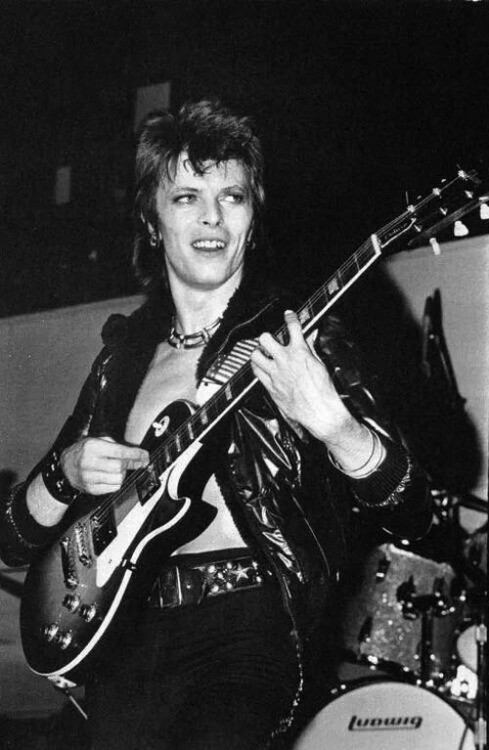 David Bowie playing a Gibson Les Paul guitar
David Bowie playing a Gibson Les Paul guitar
Alt text: David Bowie playing a classic Gibson Les Paul electric guitar.
Gifted to Bowie by Gibson, he played it live and in the ‘Jean Genie’ promotional film. However, given his penchant for more unconventional guitars, the Les Paul soon became Mick Ronson’s backup guitar and was rarely, if ever, used by Bowie again.
11) 1974 Hagstrom I Kent PB-24-G: Diamond Dogs Era Icon
Now we enter the realm of truly iconic David Bowie electric guitars. The red Hagstrom I Kent PB-24-G guitar became Bowie’s first signature electric guitar, instantly recognizable and deeply associated with his ‘Diamond Dogs’ era. Eastwood Guitars has even revived this classic model, allowing modern players to experience its unique charm.
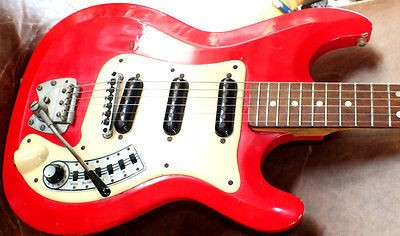
Alt text: A striking red Hagstrom I Kent PB-24-G electric guitar, famously used by David Bowie.
Despite its iconic status, the red Hagstrom was primarily used in promotional photos for the ‘Diamond Dogs’ album and a few television appearances. While Bowie played most guitar parts on ‘Diamond Dogs,’ session recollections suggest his primary studio guitar was a Dan Armstrong plexiglass model – a guitar he was never publicly photographed with.
12) 1976 Dan Armstrong 341: Station to Station Sound
Yes, David Bowie did own a Dan Armstrong guitar, but it wasn’t the plexiglass model often mentioned. This Dan Armstrong 341, auctioned in 1991, is a significant instrument in Bowie’s history. Featured in a prominent photo used for the Sound + Vision compilation, it also played a crucial role in the creation of one of Bowie’s most acclaimed albums. Bowie himself stated in 1991: “I’ve had this Dan Armstrong guitar since the early 70s. I wrote most of the songs for Station to Station on it.” Chronologically, it’s plausible it was also used during the ‘Diamond Dogs’ sessions.
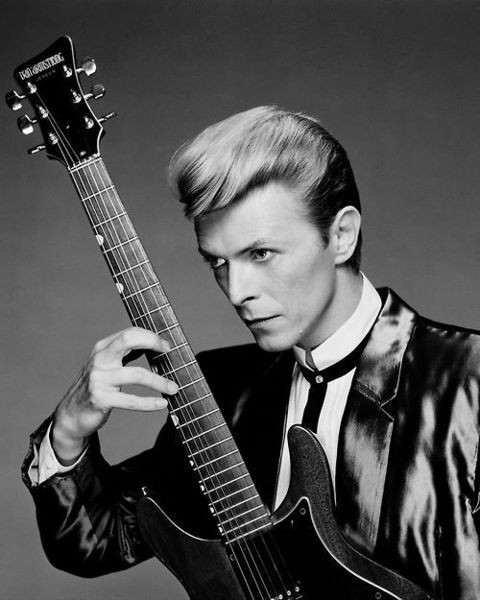 David Bowie playing his Dan Armstrong 341 electric guitar
David Bowie playing his Dan Armstrong 341 electric guitar
Alt text: David Bowie playing his Dan Armstrong 341 electric guitar, used in the recording of Station to Station.
13) 1976 Custom Fender Telecaster, Natural: Station to Station Tour
During the ‘Station To Station’ tour, Bowie played a custom Fender Telecaster. This unique Telecaster featured a natural finish and was equipped with three pickups, each with individual on/off switches. A visually striking and sonically versatile guitar, it remains a unique piece in Bowie’s guitar history, rarely seen after this tour.
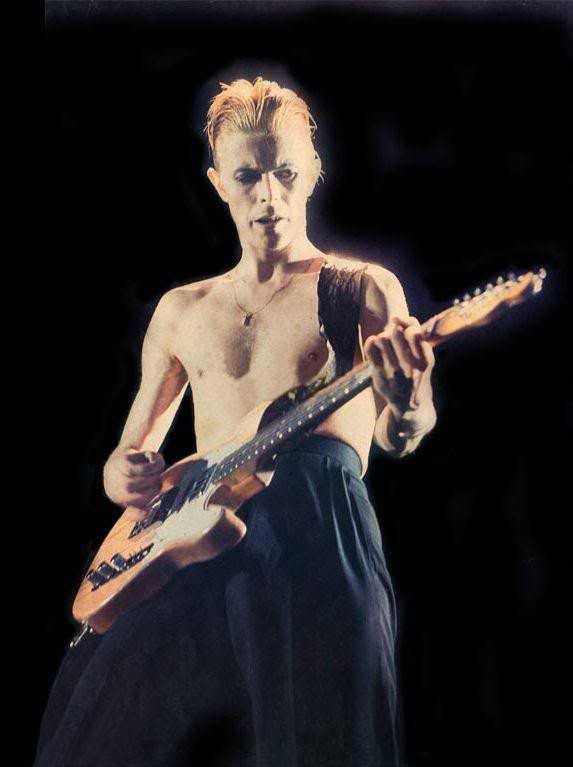 David Bowie playing a customized natural Fender Telecaster
David Bowie playing a customized natural Fender Telecaster
Alt text: David Bowie playing a custom natural finish Fender Telecaster with three pickups.
14) 1977 Fender Stratocaster, Red and Sunburst: Low Era Strats
During Bowie’s experimental and groundbreaking 1977 period, he embraced more conventional guitar choices, notably Fender Stratocasters. In the promotional video for ‘Be My Wife,’ a relatively commercial track from ‘Low’, Bowie is seen playing a red Stratocaster.
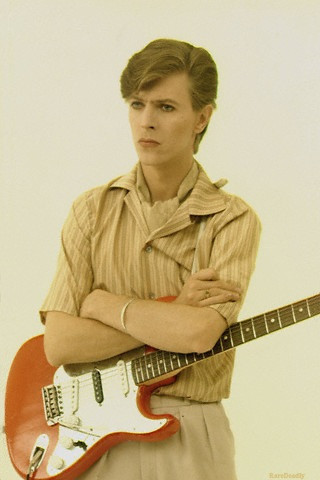 David Bowie playing a red Fender Stratocaster
David Bowie playing a red Fender Stratocaster
Alt text: David Bowie playing a red Fender Stratocaster guitar in 1977.
That same year, Bowie was also spotted playing a sunburst Stratocaster during a duet with Marc Bolan on Bolan’s TV show. Interestingly, this sunburst Strat belonged to Marc Bolan, who generously lent it to Bowie when he arrived for the show without a guitar.
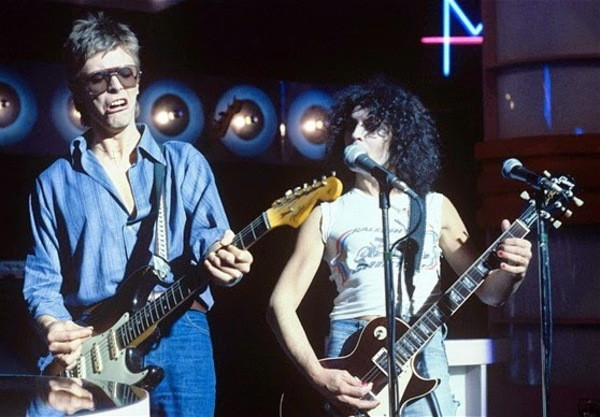 David Bowie with a Fender Stratocaster alongside Marc Bolan
David Bowie with a Fender Stratocaster alongside Marc Bolan
Alt text: David Bowie playing a sunburst Fender Stratocaster next to Marc Bolan.
15) 1989-90 Gibson L4, Black: Tin Machine Era
This black Gibson L4 archtop guitar was a constant companion for David Bowie during his Tin Machine project. He used it extensively in the studio, on stage, and on tour with Tin Machine. A Sound + Vision tour program even depicts Bowie playing this very guitar. Reeves Gabrels provided a signed letter of authenticity for this instrument, which can be seen in Tin Machine 1 album videos and was heavily used in the recording of Tin Machine II.
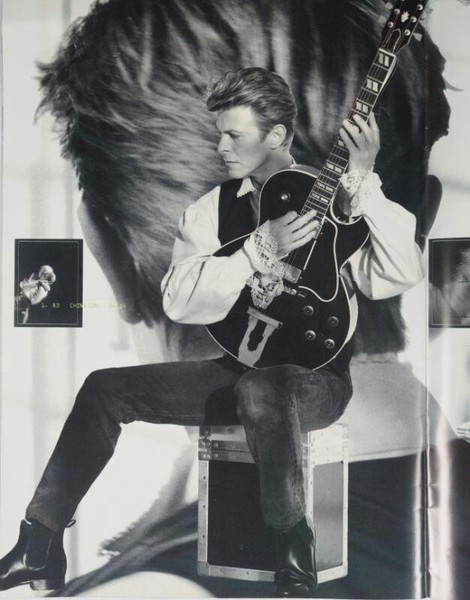 David Bowie playing his black Gibson L4 guitar
David Bowie playing his black Gibson L4 guitar
Alt text: David Bowie playing his black Gibson L4 archtop guitar during his Tin Machine period.
16) 1990 Gibson Chet Atkins Country Gentleman, Wine Red: Sound+Vision Tour
This wine red Gibson Chet Atkins Country Gentleman guitar graced the stage with Bowie during his extensive March-September 1990 Sound + Vision World Tour. It continued to be a studio favorite, later used during sessions for his 1995 concept album “Outside.”
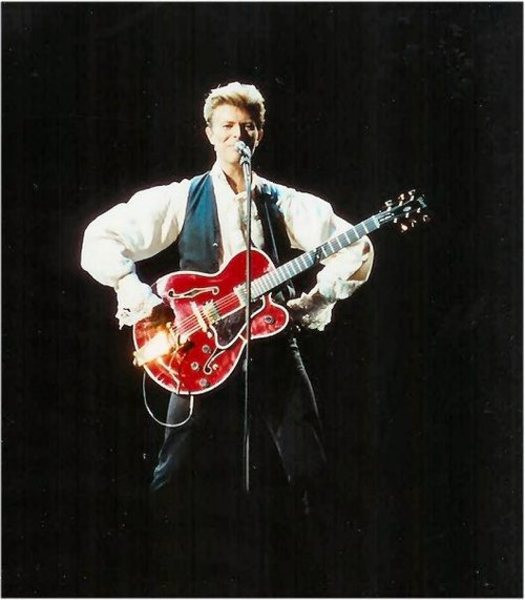 David Bowie playing his wine red Gretsch Chet Atkins Country Gentleman guitar
David Bowie playing his wine red Gretsch Chet Atkins Country Gentleman guitar
Alt text: David Bowie playing a wine red Gibson Chet Atkins Country Gentleman guitar on stage.
17) 1990 Takamine FP 400SC: Sound+Vision Acoustic
During his 1990 Sound + Vision tour, Bowie’s main acoustic guitar was this Takamine FP 400SC. He played it on iconic hits like ‘Space Oddity’ throughout the 108 concerts across seven months and over 80 cities worldwide. The Sound + Vision tour was promoted as a “greatest hits” tour, and Bowie declared it would be the last time he would perform many songs from his back catalog, making this Takamine a witness to a significant moment in his career.
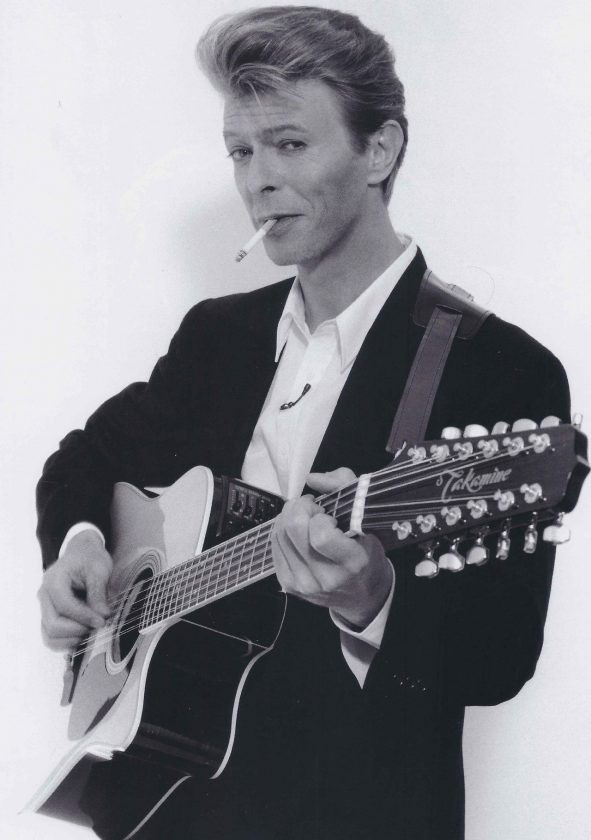 David Bowie playing his Takamine FP 400SC 12-string acoustic guitar
David Bowie playing his Takamine FP 400SC 12-string acoustic guitar
Alt text: David Bowie playing his Takamine FP 400SC 12-string acoustic guitar during the Sound+Vision tour.
18) 1991-92 Steinberger GL2, Custom Silver: Headless Innovation
David Bowie became fascinated with headless guitars after seeing Tin Machine bandmate Reeves Gabrels’ Steinberger. This led to Bowie acquiring a custom silver Steinberger GL2. According to Gabrels, Bowie’s guitar tech contacted Steinberger to create a chrome L-series guitar for Bowie. They used a test run model with a standard fretboard, making Bowie’s Steinberger playable, unlike Gabrels’ chrome-fretboard version.
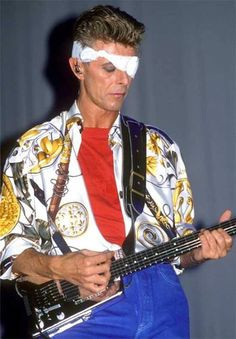 David Bowie playing his custom silver Steinberger GL2 guitar
David Bowie playing his custom silver Steinberger GL2 guitar
Alt text: David Bowie playing a custom silver Steinberger GL2 headless guitar.
19) 2003 Supro Dual Tone: Reality Tour Sound
The Supro Dual Tone became one of Bowie’s most recognizable guitars in his later years. He played it during his final world tour in 2003, and it features prominently on the cover of his 2010 live album from that tour, ‘A Reality Tour’.
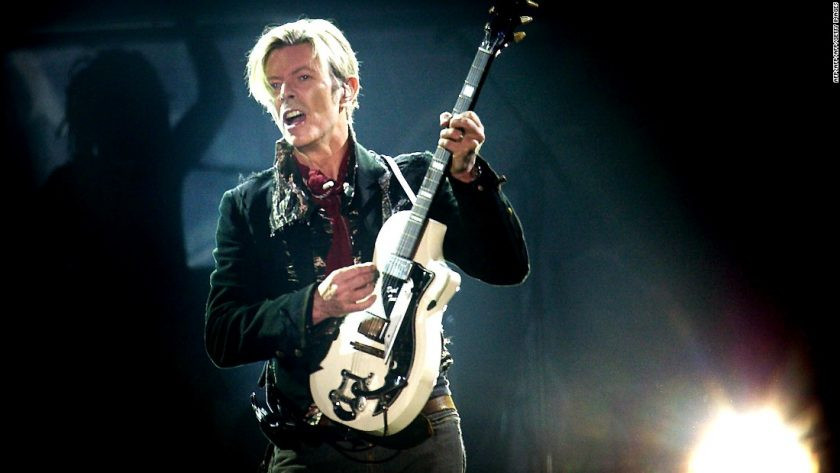 David Bowie playing his Supro Dual Tone guitar
David Bowie playing his Supro Dual Tone guitar
Alt text: David Bowie playing his Supro Dual Tone electric guitar during his later career.
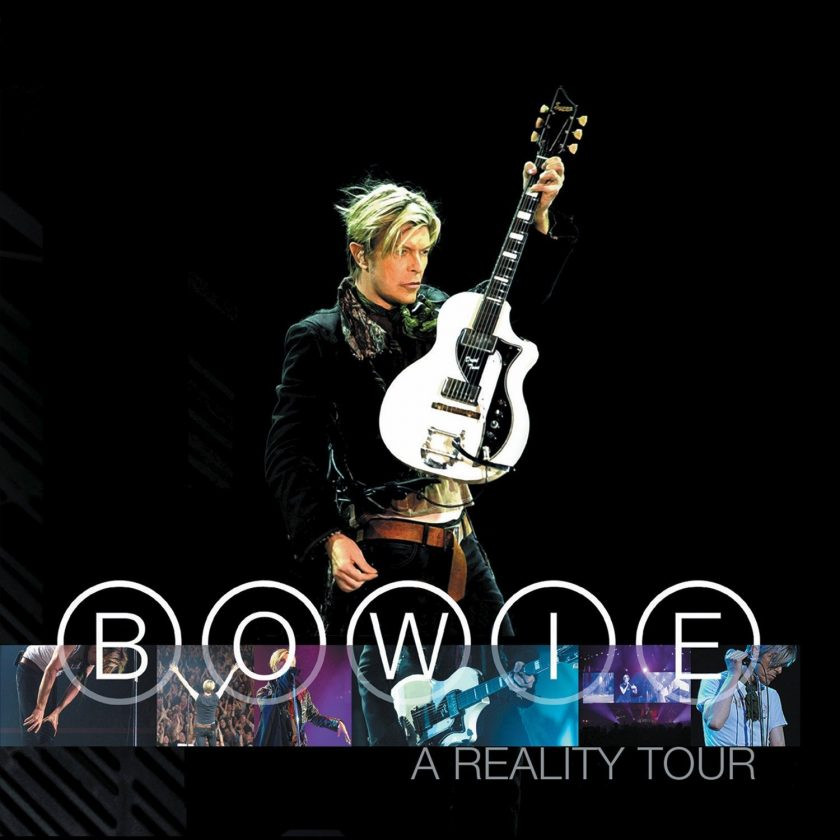 David Bowie's 'A Reality Tour' album cover featuring him with a Supro Dual Tone guitar
David Bowie's 'A Reality Tour' album cover featuring him with a Supro Dual Tone guitar
Alt text: Album cover of David Bowie’s ‘A Reality Tour’ live album, showing him playing a Supro Dual Tone guitar.
Eastwood Guitars has created a well-regarded reissue of this model, the Airline Twin Tone, offering guitarists a chance to capture a piece of Bowie’s sonic legacy.
20) 2013 Hohner G2, Red: The Final Video
Bowie returned to the headless guitar concept in the music video for ‘Valentine’s Day’ from his critically acclaimed comeback album ‘The Next Day.’ He played a red Hohner G2, another unconventional choice that perfectly aligned with his history of embracing unique and intriguing instruments. This Hohner G2 was a fitting final guitar appearance for an artist who consistently defied expectations and redefined musical boundaries.
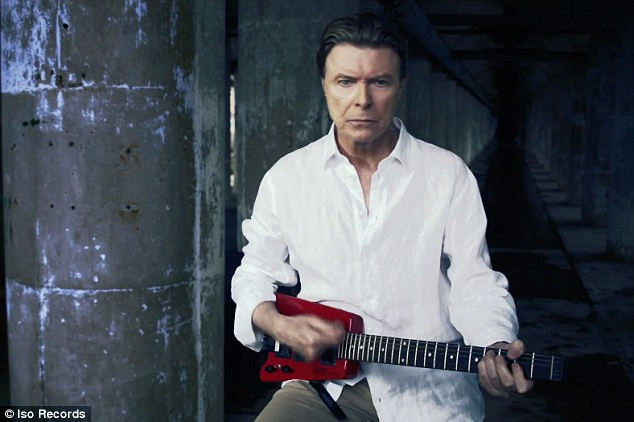 David Bowie playing his red Hohner G2 headless guitar
David Bowie playing his red Hohner G2 headless guitar
Alt text: David Bowie playing a red Hohner G2 headless guitar in his final music video.
David Bowie’s guitar journey is a reflection of his artistic evolution. From 12-string acoustics to innovative electric models, his choices were always deliberate and contributed to his distinctive sound and image. Exploring David Bowie’s guitars offers a deeper appreciation for the multifaceted genius of this musical icon.

